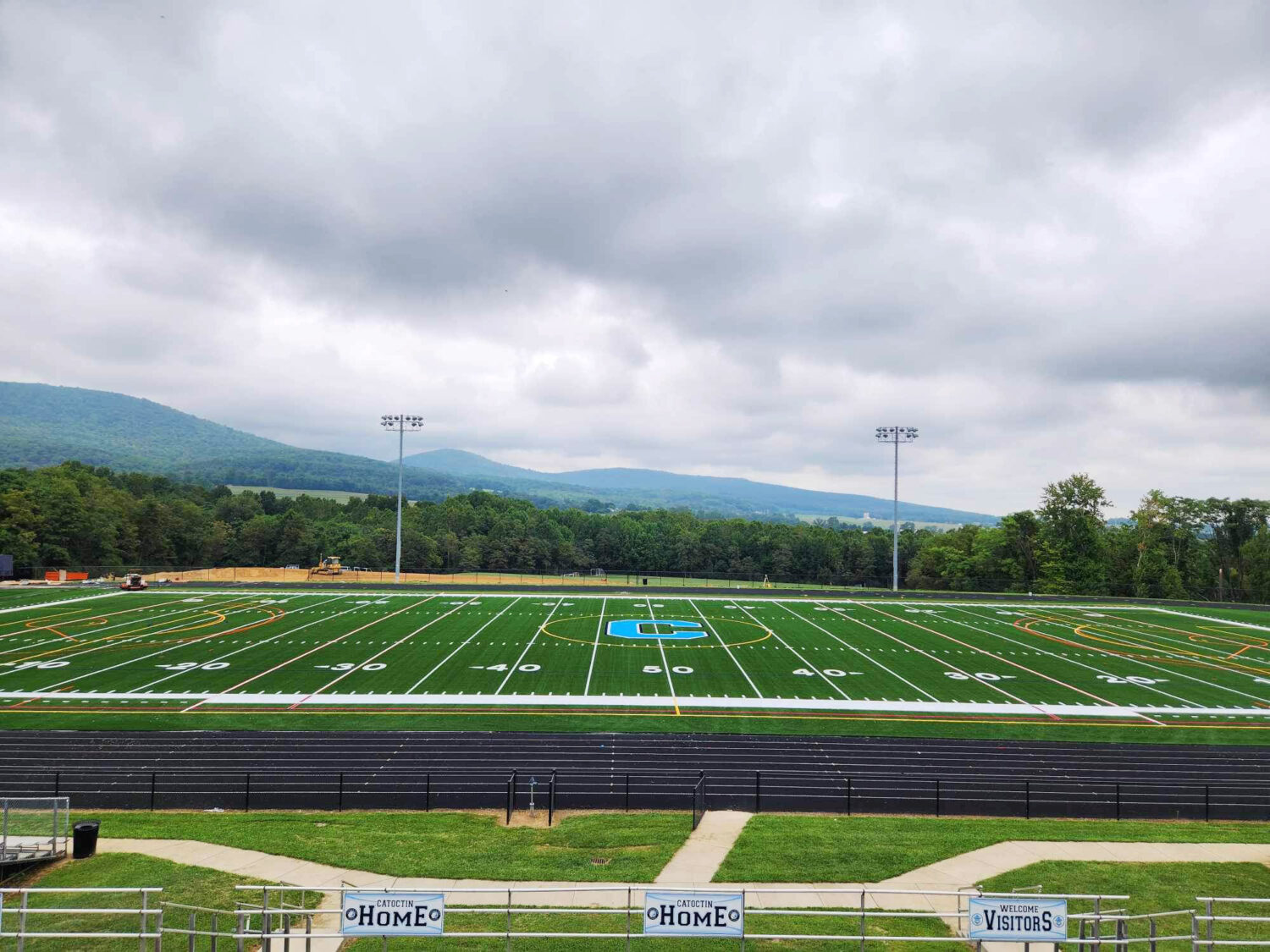
Brunswick, Catoctin, Tuscarora and Walkersville high schools have new turf fields installed to start the 2023-24 school year! Now, every high school in the county has at least one turf field.

Brunswick, Catoctin, Tuscarora and Walkersville high schools have new turf fields installed to start the 2023-24 school year! Now, every high school in the county has at least one turf field.
FIRST Robotics Competition (FRC) Team 686, Bovine Intervention, located in Thurmont, composed of students from Catoctin, Walkersville, and Oakdale High Schools and Walkersville Middle School, competed at the 2023 FRC Chesapeake District Championship at George Mason University, EagleBank Arena, on April 6, 7, and 8.
Teams 686 is one of five FRC high school level robotics programs in Frederick County. Prior to competing at the District Championship event, they competed in two FRC Chesapeake District qualifier events in March with other teams across the FIRST Chesapeake District areas of Maryland, the District of Columbia, and Virginia. Based on Team’s 686’s overall accomplishments at the competitions in March, they advanced to be among 60 teams competing at the FRC Chesapeake District Championship three-day event. This championship event is one of many regional events across the United States. It had 120 competition matches and playoffs and serves as the stepping-stone with awards and rank earnings for select teams to compete at the FIRST Championship (World competition) in Houston, Texas. Teams 686 and 8726 finished the regional event in the mid-rankings but were not selected to compete in the 24 teams’ playoff rounds or advance to the FIRST Championship in Houston, Texas. Therefore, this completes their 2023 FRC season. Besides rankings earned during the competitions, Team 686 earned a Creative Design Award for their robot turret design at the Chesapeake District Championship. To reach this accomplishment, Team 686 Bovine Intervention conducted team-building, introduction to tools, and robot design and build during the summer and fall of 2022. Team 686 participated in the FIRST off-season competitions in August, October, and December. This prepared students to understand FIRST and robot competitions. As a result, students were ready for the 2023 FRC design, build, and testing of a 125-pound competition robot in response to the reveal of the 2023 FIRST tasks and strategic-oriented game in January 2023.
For the 2022 and 2023 school year, Frederick County students were inspired and gained educational experience as a response to tasks provided by the FIRST organization. Students learned and worked on electrical and mechanical engineering practices using Computer Assisted Drawing (CAD) software tools, applications, systems prototyping, assembly of structural and electrical components to a robot, advanced computer programming, and final laboratory test and refinement to complete a finished product. Students used various advanced additive and subtractive manufacturing equipment to include 3D printing, Computer Numerical Control (CNC), lathe, drill press, saws, and other types of tools. To expand on the aspects of advanced programming, students build extensive program coding for driving the robot and forming autonomous operations using measurements, calculations, and sensor readings for spatial locations. Overall, these robotics programs operate based on the FIRST organization to inspire young people by engaging them in exciting mentor-based programs that build science, engineering, and technology skills, which inspires innovation and fosters well-rounded life capabilities, such as self-confidence, communications, and leadership. Students engaged in teamwork and performed marketing, outreach, and collaboration with other robotics programs at or outside of competitions.
Mentors, teachers, and student alumni help guide and prepare these students for opportunities in the 21st century workforce. As vibrant as these programs can be, most of the operational capabilities are based on support from grants, sponsors, families, donations, and volunteers. Additionally, the State of Maryland provides property tax credits to property owners who qualify and support robotics programs with a space to operate. Teams continually seek out such support.
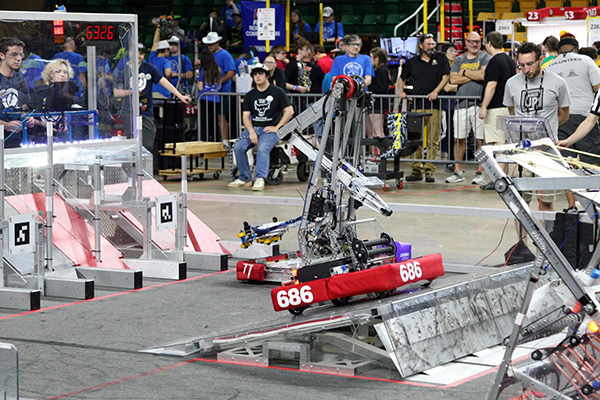
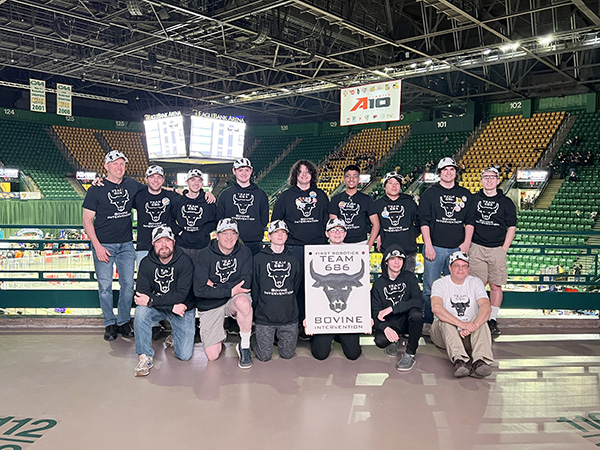
Courtesy Photos FRC Team 686, Bovine Intervention, 2023 FRC Chesapeake District Championship
Blair Garrett
Craftsmanship comes in many forms. One can specialize in a variety of fields, from cooking to painting to construction.
But right here in the Catoctin area lives one of the most talented craftsmen around.
Blacksmithing and metalworking extraordinaire, Robert Bittner, 27, of Sabillasville, has found his niche creating entirely unique custom cars and fueling his creative outlets with hand-crafted projects made from whatever scrap metal he can find.
After spending most of his childhood on a farm and thinking that was where his career was headed, Bittner found a new direction in quite an unusual way. “I started in high school,” Bittner said. “I didn’t want to take Spanish, so I had to take a career course. I went to CTC for welding, and I got really good at it. I went to nationals for skills USA, and I ranked really high in the nation and just kept going.”
As a kid, Bittner found drawing as a sufficient way to take ideas and create them into something physical, which may have been a precursor that lead him to where he is now.
Making it as an artist outside of a major metropolitan area is an increasingly difficult avenue for a career, therefore logically, Bittner chose something with a bit more stability, contracting with a roofing company.
Bittner worked the roofing job for a year, but quickly found out that wasn’t the path for him. He landed at a shop nearby, which changed everything for him. “After roofing, I got a job at Hauk Designs in Pennsylvania, building one-off custom jeeps,” Bittner said. “I always liked the custom side of everything, especially vehicles.”
Bittner and the team at Hauk Designs caught the eye of some reps from the History Channel with one of their vehicles at SEMA, the biggest invite-only car show in the world.
That launched the opportunity to showcase their metalworking talents to a larger audience in 2017 as they filmed the TV show Road Hauks. Each episode followed the design and fabrication process to build custom jeeps and vehicles from scratch into a photoshoot-worthy and fully operational pieces of machinery.
The exposure for Bittner and company allowed them to take and build more cars for shows as far as Las Vegas, showing the world what they could do.
The exposure from the show even spun off into other lucrative projects. “A guy in Taiwan sent us $150,000 and said, ‘build me a jeep I can’t kill,’” Bittner said. “I built and designed a full exo-cage, fenders, bumpers, $15,000 worth of just axles.” Those are the projects an artist like Bittner thrives on. “If I could, I would do these all the time.”
Today, Bittner has the means to take those ideas and put them into a tangible metal work of art, with an unbelievable amount of detail and uniqueness you can’t find anywhere else, and he plans on doing it just from the comfort of his home in Sabillasville under his new business Har-Valley Forge and Fab Works.
While he is commissioning personal art pieces for locals, like his popular hand-crafted metal roses, he still makes time to work on the things he loves most.
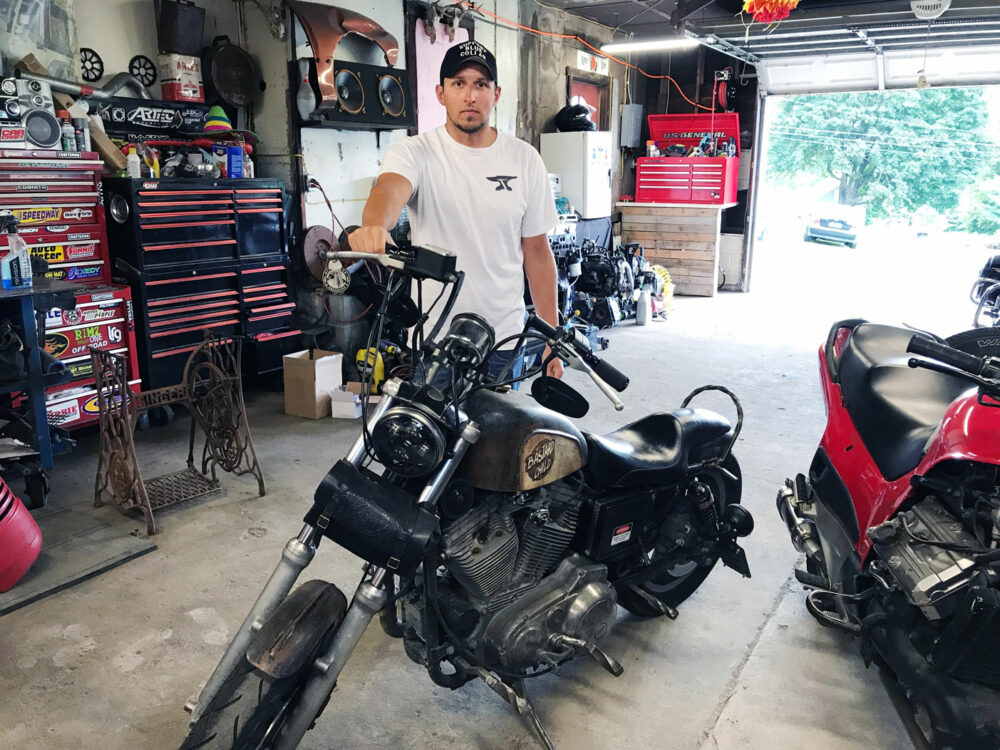
“My motorcycle I built from the ground up. It’s a Sportster that I completely customized top to bottom,” he said. Nearly the entire motorcycle is fully hand-built, aside from the Jack Daniels plate on the frame of the vehicle. There isn’t a piece exactly like it in the world.
Bittner has a promising road ahead of him, and with new projects and ideas coming to mind every day, it feels like it’s only a matter of time until we see his work on the big stage again.
Before the Catoctin High Varsity Girls Basketball game on Thursday, December 20, 2018, the gymnasium was more crowded than usual as alumni girls basketball players attended a special ceremony to commemorate the school’s 50th anniversary.
Other sports will hold similar events, some during their senior night games. The following are Catoctin High School’s Senior and Alumni Nights for winter 2019 sporing events: Swimming—January 7; Wrestling—January 8 (alumni night) and February 6 (senior night); Unified Bocce—January 24; Boys Basketball—February 8 (senior night) and February 12 (alumni night); Girls Basketball—February 15 (senior night); and Indoor Track—February 8.
Any former players and coaches are invited back for Alumni Nights.
Jim Schlett
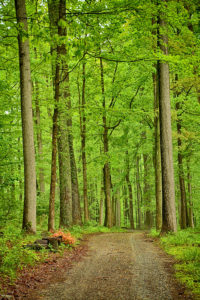 When our National Parks were first established, well over a century ago, painters and photographers created works that inspired Americans and people from around the world to journey and visit those areas and to generate interest in the parks. That practice lives on to this day. The National Park Service (NPS) still reaches out to potential “artists” through its Artist-In-Residency (AIR) program, which is available at over forty different locations.
When our National Parks were first established, well over a century ago, painters and photographers created works that inspired Americans and people from around the world to journey and visit those areas and to generate interest in the parks. That practice lives on to this day. The National Park Service (NPS) still reaches out to potential “artists” through its Artist-In-Residency (AIR) program, which is available at over forty different locations.
After retiring from the Federal government with over thirty years of service, including the last fifteen as the director of administration for the Law Department, I decided to “refocus” on my photography. Through a very competitive application process, I was notified that I had been selected as the AIR at Catoctin Mountain Park for two weeks in May. Like other painters, my photos tell a story with images rather than words. I had been very fortunate to have been selected as the AIR at the Whiskeytown National Park Recreation Area in Northern California in 2016, so I had a good idea of what I wanted to accomplish and share with the Catoctin Park staff. Each park asks that the artist donate one piece of their work back to the Park after the residency is completed and to give a workshop/talk to the public during the residency.
My wife and I arrived on Sunday, May 6, 2018, in light rain, which created a bright spring green on our drive up from Virginia that I hoped would make for great photos over the next two weeks. That ride sparked a conversation about our great interest in our National Parks, dating back to the early 1980s with our first trip to Yellowstone and the Grand Tetons, now having visited over 140 sites to-date.
Based on my prior AIR experience at Whiskeytown Park, I kept a detailed journal of each day, touching on such activities as hikes, the people we met, and notes for future exploring. As part of the program, the park provides lodging to the artists. My wife and I were assigned housing at Camp Misty Mount, a historical complex of cabins built in the 1930s by the Works Progress Administration. On our first day, we met AIR Coordinator Carrie Andresen, a dedicated park ranger, who provided us with an excellent overview of the park, potential workshop dates, introduced other park employees and volunteers, and also talked about on-going events of the park. Afterward, we unpacked the car in now heavy rain and settled into the cabin. I was able to take just a few images of the surrounding area and cabins for the first afternoon; we then made our way down to the Kountry Kitchen in Thurmont for a great dinner.
In addition to creating my own images of the park, I had made an offer to take photos of the park employees and volunteers during my stay. As a result, I managed to meet many employees and volunteers, who all went the extra mile in terms of reaching out to me and all of the visitors to the park. Catoctin Park provided space in the Visitors Center for the display of my photography; so, on the first Monday, we installed about fifteen of my canvas prints. I also provided a daily update of three to four new images for each day at the park, which were also posted at the Visitors Center, as well as on their Facebook page and mine. Over the two weeks, we hiked essentially all of the trails, and some more than once. I was amazed at the quietness and peaceful feeling of just being in the park. I discovered what many of the locals must know, it really is a hidden gem in the National Park Service. Enjoying American history at the same time, I learned of the creation of the park and its legacy, including training grounds for the Office of Strategic Services (OSS), the predecessor to the CIA, during World War II.
It doesn’t take long in a National Park to find inspiration for creating new work. As an example, a simple, relatively easy walk along the Blue Blazes Trail would lead to hundreds of photos of the stream, trees, flowers and eventually the whiskey still. During one of my photo workshops, two of the participants were quickly laying down on the ground, capturing close-ups of what they described as a rare flower find by its scientific name. On a few days, a heavy fog and mist—which I was excited to see—provided unique lighting for new images. I find that light plays a critical role in finding photographs, and that is why I often go back to specific locations several times to try and capture just the right light. The light can make the difference between a good photograph and a great one. Wandering around also has its benefits when searching for new photographic opportunities, and I took full advantage of wandering while in the AIR program. Every morning involved a short walk from the cabin, within a 200-yard radius, that brought me in contact with many varieties of flowers, trees, and wildlife that often set the tone for the day.
My efforts were geared to try to take meaningful photographs of Catoctin that are so hard to put into words. It has been said that our National Parks are one of “America’s Best ideas,” and I truly feel that is so true. In our parks, I sense a re-connection to nature and the universe that is so needed in today’s fast-paced society and world. As John Muir said, “come to the woods, there is rest.” We were so enthralled with the park, we invited several of our friends from Northern Virginia to travel up to spend the day, and we became tour guides in exploring the park; they all greatly enjoyed the experience.
As Ansel Adams, a world-renowned photographer and friend of the National Parks, had remarked something to the effect … good photographs occur when you figure out the right place to stand. I spent a great deal of time looking for those “right places,” and part of the richness of the Catoctin is that the hiking journey gives as much inspiration as the destination, such as Chimney Rock or the Thurmont Vista. Most days, we walked six to ten miles within the park. With a full two weeks in the park, I never tired of exploring and heading out for more springtime photos, and yet the time raced by us until our departure on May 19.
Being in a National Park gives one time to get in touch with nature, and my time at Catoctin Mountain Park gave me that and much more. We had some time to explore other nearby areas, such as the covered bridges, the Seton Shrine, and the back roads, as well as the hospitality of the folks of Thurmont and the region. Even though the Residency came to an end too quickly, I have already made plans for more return visits, with the changing of the seasons at Catoctin. Since I took many images, one of the difficult and time-consuming tasks has been to edit my work down to the best ten to fifteen prints for future exhibitions. I am hopeful that people will respond to my work in ways that will benefit the park itself, such as new volunteers for Catoctin Park or the Catoctin Forest Alliance. I will also be exhibiting some of my photographs from the Catoctin experience at the ArtSpace Gallery in Herndon, Virginia, later this year.
More of my photographic images in individual galleries by subject matter can be found at www.hotomanva.zenfolio.com.
By artist Jim Schlett, taken in Camp Misty Mount, within 200 yards of his cabin. “The lighting at that early morning, with a light fog, created a sense of being invited in to the forest.”